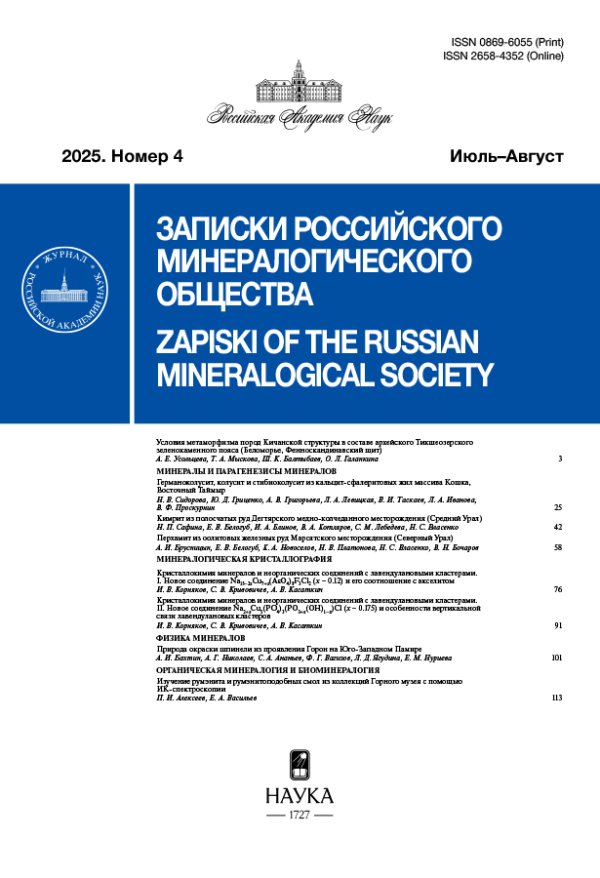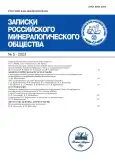DFT-моделирование системы водородных связей в самплеите
- Авторы: Паникоровский Т.Л.1,2, Яковенчук В.Н.1, Пахомовский Я.А.1, Коноплёва Н.Г.1, Иванюк Г.Ю.1, Антонов А.А.1, Шиловских В.В.3, Кривовичев С.В.1,2
-
Учреждения:
- Кольский научный центр РАН
- Санкт-Петербургский государственный университет, кафедра кристаллографии
- Санкт-Петербургский государственный университет, Ресурсный центр “Геомодель”
- Выпуск: Том CLII, № 5 (2023)
- Страницы: 83-99
- Раздел: МИНЕРАЛОГИЧЕСКАЯ КРИСТАЛЛОГРАФИЯ
- URL: https://journals.rcsi.science/0869-6055/article/view/148110
- DOI: https://doi.org/10.31857/S0869605523050052
- EDN: https://elibrary.ru/RXNCFN
- ID: 148110
Цитировать
Полный текст
Аннотация
В статье приводится кристаллохимическое описание второй находки P21/n модификации самплеита NaCaCu5(PO4)4Cl·5H2O, сделанной на Кестёрском оловорудном месторождении. Образование минерала генетически связано с низкотемпературными процессами окисления первичных сульфидов меди, цинка и олова, а также с формированием более поздних Cu-, Zn-фосфатов, таких как батагаит, епифановит и сергейсмирновит. С помощью DFT-метода произведeн расчeт положений атомов водорода в структуре самплеита. В качестве оценки достоверности теоретических расчeтов проведено сравнение реального и теоретического ИК-спектров. Самплеит образовался на стадии гидротермального изменения сульфидных минералов Sn, Cu и Zn и сосуществовал с епифановитом NaCaCu5(PO4)4[AsO2(OH)2]·7H2O, который, несомненно, является более поздним, но имеет меньшую сложность (IG,total), 474.24, чем самплеит 933.32 (бит/яч).
Об авторах
Т. Л. Паникоровский
Кольский научный центр РАН; Санкт-Петербургский государственный университет, кафедра кристаллографии
Автор, ответственный за переписку.
Email: taras.panikorovskii@ksc.ru
Россия, 184200, Мурманская обл., Апатиты, ул. Ферсмана, 14; Россия, 199034, Санкт-Петербург, Университетская наб., 7/9
В. Н. Яковенчук
Кольский научный центр РАН
Email: taras.panikorovskii@ksc.ru
Россия, 184200, Мурманская обл., Апатиты, ул. Ферсмана, 14
Я. А. Пахомовский
Кольский научный центр РАН
Email: taras.panikorovskii@ksc.ru
Россия, 184200, Мурманская обл., Апатиты, ул. Ферсмана, 14
Н. Г. Коноплёва
Кольский научный центр РАН
Email: taras.panikorovskii@ksc.ru
Россия, 184200, Мурманская обл., Апатиты, ул. Ферсмана, 14
Г. Ю. Иванюк
Кольский научный центр РАН
Email: taras.panikorovskii@ksc.ru
Россия, 184200, Мурманская обл., Апатиты, ул. Ферсмана, 14
А. А. Антонов
Кольский научный центр РАН
Email: taras.panikorovskii@ksc.ru
Россия, 184200, Мурманская обл., Апатиты, ул. Ферсмана, 14
В. В. Шиловских
Санкт-Петербургский государственный университет, Ресурсный центр “Геомодель”
Email: taras.panikorovskii@ksc.ru
Россия, 1198504, Санкт-Петербург, Ульяновская ул., 1,
С. В. Кривовичев
Кольский научный центр РАН; Санкт-Петербургский государственный университет, кафедра кристаллографии
Email: taras.panikorovskii@ksc.ru
Россия, 184200, Мурманская обл., Апатиты, ул. Ферсмана, 14; Россия, 199034, Санкт-Петербург, Университетская наб., 7/9
Список литературы
- Антонов А.А. Получение синтетических аналогов минеральных видов – фосфатов – арсенатов меди: самплеита, лавендулана, епифановита. Термодинамический подход // Фундаментальные проблемы современного материаловедения. 2019. Т. 16(1). С. 78–83.
- Кокунин М.В. Редкие минералы забытого месторождения // Отечественная геология. 2011. № 1. С. 72‒82.
- Зубкова Н.В., Пущаровский Д.Ю., Сарп Х., Тит С.Дж., МакЛин Э.Дж. Кристаллическая структура зденекита, NaPbCu5(AsO4)4Cl·5H2O // Кристаллография. 2003. Т. 48. № 6. С. 1006–1011.
- Зубкова Н.В. Сравнительная кристаллохимия новых и редких цирконосиликатов, силикатов щелочных и щелочноземельных элементов и минералов с изолированными тетраэдрическими и треугольными оксокомплексами. Автореферат … уч. ст. д.г.-м.н. Москва, 2012.
- Павловский А.Б., Печенкин А.Г., Луговская И.Г. Геолого-промышленные типы месторождений полезных ископаемых. В сб.: Олово. М.: ВИМС, 2015. 52 с.
- Паникоровский Т.Л., Кривовичев С.В., Яковенчук В.Н., Иванюк Г.Ю. Кристаллическая структура епифановита // ЗРМО. 2017. Т. 146. № 3. С. 39–50.
- Яковенчук В.Н., Пахомовский Я.А., Коноплёва Н.Г., Паникоровский Т.Л., Михайлова Ю.А., Бочаров В.Н., Кривовичев С.В., Иванюк Г.Ю. Епифановит NaCaCu5(PO4)4[AsO2(OH)2]·7H2O – новый минерал из месторождения Кестёр (Саха-Якутия, Россия) // ЗРМО. 2017. Т. 146. № 3. С. 30–39.
- Яковенчук В.Н., Пахомовский Я.А., Коноплёва Н.Г., Паникоровский Т.Л., Базай А.В., Михайлова Ю.А., Бочаров В.Н., Кривовичев С.В. Сергейсмирновит MgZn2(PO4)2·4H2O – новый минерал из месторождения Кестёр (Саха-Якутия, Россия) // Доклады РАН. Науки о земле. 2022. Т. 505(2). С. 165–169.
Дополнительные файлы
















